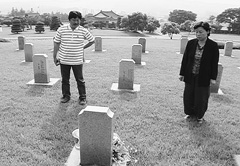Annyong, Sayonara
 KOREA, JAPAN / 2005 / Korean, Japanese / Color / Video / 100 min
KOREA, JAPAN / 2005 / Korean, Japanese / Color / Video / 100 min
Director: Kim Tae-il
Co-Director: Kato Kumiko
Photography: Ji Hye, Takabe Yuko
Music: Chung Hye-won
Planning: Kim Eun-sik, Honda Tsunao
Narrative Structure: Hong Seong-hwa
Animation: Kim Hye-jeong
Assistant Director: Ji Hye
Coordinators: Choi Jina, Chung Ji-hye, Namba Koji
Producer: Kim Il-kwon
Production Committee, World Sales: KOREA-JAPAN Joint Documentary Project
Lee Hee-ja, a Korean woman, joins a lawsuit to have her father, who was drafted by the Japanese army and killed in action during World War II, “de-shrined” from Yasukuni Shrine. Furukawa Masaki, a member of a Japanese support organization for the lawsuit by former military and military-related personnel living in Korea, assists her case. As the Japanese and Korean film crew, none of whom have experienced the war firsthand, collaborate in collecting diverse opinions regarding Yasukuni Shrine, they look back on the sixty years since the end of World War II to arrive at the present. Their journey through Japan, Korea, Okinawa and China exposes the close but turbulent relationship between Japan and Korea.
[Director’s Statement] Efforts to resolve historical issues between Japan and South Korea have been plagued with the regurgitation of the same old rhetoric. My aim with this documentary was to seek a solution of sorts for this problem. I also wanted to identify what was needed to bring peace to the Asian nations, especially the threatening feeling of Japan’s recent drift to the right. Collaborative work between the two film crews was not easy, but it certainly allowed me to catch a deep glimpse of Japanese society. Through encounters with strong-willed and warm-hearted individuals, I feel that I have found direction.
[Co-director’s Statement] In making this documentary, the collaborative work between Japanese and Korean staff was itself a process of acknowledging and understanding the various chasms that exist between the two countries. By empathizing with the emotional state of the two protagonists in Annyong, Sayonara, our hope is that the audience will consider why Korea is upset about Yasukuni, how the Japanese feel about this, and why Yasukuni and the Japanese cannot understand the Korean perspective. Let us bid “Sayonara” to the painful histories of the past.
 Kim Tae-il
Kim Tae-il
Born in 1963, Kim Tae-il started filmmaking in 1991. He became a member of P.U.R.N. Production in 1993, and has since produced A Purple Handkerchief (1995), which was screened at New Asian Currents in YIDFF ’97. Other works include Making the Spy (1998) and Walking for Life (2004). Currently he works as the director of Coloroutsider and the Seoul Independent DOcumentary Film & Video Festival.  Kato Kumiko
Kato Kumiko
Born in 1975, and currently residing in Tokyo, Kato Kumiko has been involved in visual production since 2002. Her debut work, What Did You Do When You Were 14 Years Old? (2002), features former “comfort women” in the Philippines. She also produced Remedias Felias’ Santama Travelogue (2002). Other works include Where To? (2003)—a film questioning the chain of violent occurrences of post-9.11 and the Japanese government’s decision to deploy the Self-Defense Forces to Iraq, and 60 Years of Sadness—The Ukishima-Maru Incident and Yasukuni Enshrinement (2005). |
